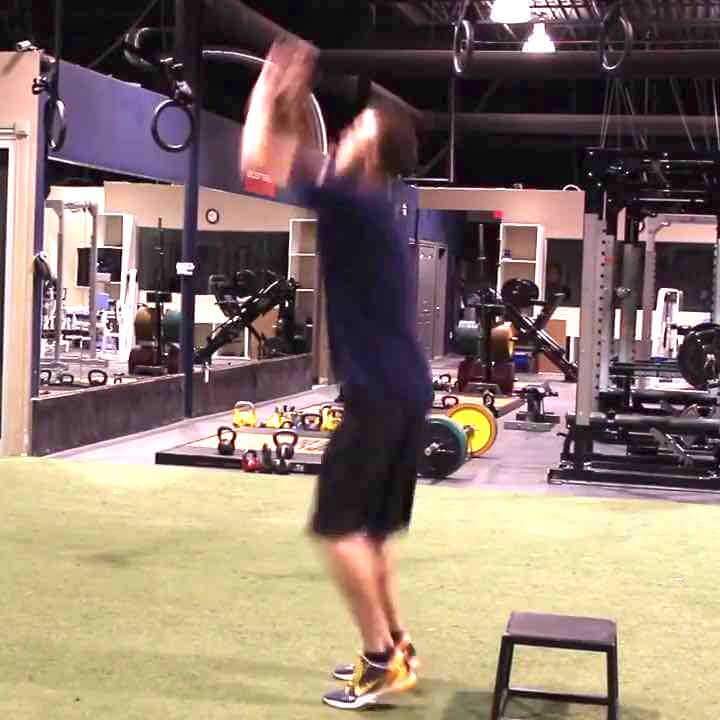Plyometric training has become immensely popular in recent years and today the term is often used synonymously with vertical jump training.
It was developed in the former Soviet Union during the 1970's as a shock method of training and was in large part responsible for the great successes of Russian Track & Field athletes during theses years.
The term "plyometric" was coined by the American coach and author Fred Wilt who saw the unusual warm-up exercises consisting of various bounds, hops, and skips of soviet athletes before competitions.
The purpose of plyometric training is described as follows:
If you want to improve your vertical you need to be able to activate your strength within a very short time frame - and plyometrics are the perfect way to teach this skill!

How do Plyometrics work?
One thing all plyometric exercises have in common is that they use the so-called "stretch shortening cycle". This is a complicated way of saying that all plyometric exercises consist of two phases: During the first phase the involved muscles are stretched, only to contract explosively in the second ("shortening") phase.
Let's illustrate this with the example of the most popular and well known plyometric exercise:
Example of a Plyometric Exercise - Depth Jump

You step off a box with your muscles in a neutral position. The height of this box should fit your overall conditioning. If you are new to plyometrics, it is safer to start with lower heights to prevent injuries.

After the landing, the muscles and tendons of your calves and quads are stretched by the downward motion. This is the "stretch phase" where the athlete tries to stop the downward motion quickly and keep the overall ground contact time as short as possible.

You reach the lowest point. Your muscles and tendons are now maximally stretched. Similar to a stretched rubber band they have energy stored that is ready to result in an explosive upward movement in the next phase.

During this "shortening phase" the muscles contract as quickly as possible. This is achieved by two main drivers:
- elastic energy stored in the tendons and muscles from the stretch phase.
- the conscious power of the muscles (calves, quads, glutes, lower back etc.)
Pictures from Adam Folker of Vert Shock
A great way to visualize the power of this "stretch-shortening cycle" is to test the height of two different jumps:
1. Deep Squat Jump:
Do a jump from a deep squat position and make sure that you do not use any kind of countermovement. This means that you are not allowed to swing down with your arms, and you are not allowed to bend your knees in the beginning. Make sure that your jump starts at the lowest point and you only move upwards.
2. Countermovement Jump:
Here, you start in an upright position and descend into the jump. Bend your knees quickly, use your arms to gain momentum and try to jump as high as possible.
What you will notice:
The countermovement jump uses the first phase to quickly descend, similar to the depth jump, but instead of dropping from a box, the athlete drops from an upright position. This way the athlete is able to use the stretch-shortening cycle to gain speed in the second phase.
Using a deep squat is a very unnatural way of jumping where you eliminate the first phase and therefore the stretch-shortening cycle completely.
Because of this, you will notice that you are able to jump much higher utilizing a countermovement in the beginning.
5 Reasons Why You Should Do Plyometrics
- Plyometric exercises are closely related to actual vertical jumping and therefore teach the "skill" of it better than pure strength training.
- Plyometrics teach the brain and the central nervous system how to fire the muscles quickly and efficiently which results in quick and significant training results. This way you learn quickly!
- Easy to learn and less injury risk than heavy weightlifting exercises
- High-intensive Plyometric Exercises also train strength
- Bodyweight exercises can be performed without expensive equipment
The most well known vertical jump training program that relies heavily on plyometric exercises to achieve goal astonishingly quickly is Vert Shock:
Alright now that you know how plyometric exercises work and why they are so efficient, let's introduce some of the best plyometric exercises:
9 Plyometric Exercises for Basketball
1. Depth Jump:
Drop off the box and as soon as you touch the ground explode back upwards trying to minimize the ground contact time as much as possible.
You can vary the height of the box: lower boxes will work more on your explosiveness (the ability to create movement from a static position), higher boxes on your reactive ability (the ability to take a great amount of force and translate it into movement in another direction).
2. Two-Foot Ankle Hops:
Stand with your feet shoulder wide apart and hop continuously only using your ankles. Make sure that you don't bend your knees and that you extend your ankles to the full range of motion during each jump. Also, try to limit the ground contact time to the absolute minimum. This is a great exercise to develop quickness in your feet.
3. Slalom Jumps:
This exercise is also often called "line jumps" because you draw a line on the ground and try to hop from one side to the other as fast as possible. Keep your core stable and look for very quick ground contacts, jump height is NOT important in this exercise. Every hop counts as a repetition and you can do this exercise staying in the same spot or moving slightly forward as shown in the video.
4. Power Skipping:
Power Skipping is a great exercise training the explosiveness off of one leg. The goal is to jump as high as possible of alternating legs while keeping a slow jog forward. While doing the exercise focus on driving the knee of the off-leg as far to the chest as possible. This exaggerated movement will improve the power of your leg swing and your one-leg vertical.
5. Rim Jumps:
Place yourself under a basketball rim an try to tap the rim with your hands. After landing, immediately bounce back up and try to touch the rim again. If you can't reach the rim you can use the backboard or do the drill in front of a wall trying to reach the highest point possible. Focus on minimal time spent on the ground, stop as soon as the jumps get significantly lower.
6. Drop and Freeze:
Step off a box that is around 18-24 inches high. Make sure to land on both feet simultaneously with your knees bent and try to stop any momentum immediately. This is a great exercise for weaker athletes that are not yet used to high-impact plyometric exercises. It prepares the body to better coordinate the high forces during landing and prepares them for real depth jumps.
7. Single-Leg Depth Jumps:
Single leg jumps should only be done by experienced athletes and the height of the box should be chosen carefully. The athlete drops off the box like in a regular depth jump, but lands on only one foot. After the landing, the athlete tries to explode back up as quickly as possible. Make sure that your knee doesn't buckle and that the center of gravity remains over the jumping leg. As an added difficulty, add a box to jump onto.
8. Hurdle Jumps
This is a very flexible exercise since you can vary the height and distance of the hurdles and use different jumps (one-foot, two-foot, sideways etc).
Focus on low ground contacts times in-between jumps to maximize the plyometric effect.
9. Bounding
Bounding is best performed in a variety of styles. You can alternate legs on every step, or go right-right, left-left or even right-right-right, left-left-left. Go for 2-3 rounds of 15-30 meters.
Final Thought
Plyometrics are by far the most efficient way to learn how to jump higher. Check out my free vertical jump program to learn how to incorporate these exercises into a complete workout.
Have you tried plyometrics yourself and what were your results? Let me know in the comments!

Founder of thehoopsgeek.com. A passionate basketball enthusiast and coding geek, Andy combines a love for sports with technology.








